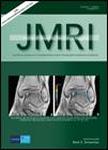版权所有:内蒙古大学图书馆 技术提供:维普资讯• 智图
内蒙古自治区呼和浩特市赛罕区大学西街235号 邮编: 010021

作者机构:Ctr Neurosci & Regenerat Med Bethesda MD USA NIH Radiol & Imaging Sci Ctr Clin Bethesda MD 20892 USA
出 版 物:《JOURNAL OF MAGNETIC RESONANCE IMAGING》 (磁共振成像杂志)
年 卷 期:2015年第41卷第6期
页 面:1695-1700页
核心收录:
学科分类:1001[医学-基础医学(可授医学、理学学位)] 1009[医学-特种医学] 10[医学]
基 金:Intramural Program in the National Institutes of Health Department of Defense in the Center for Neuroscience and Regenerative Medicine (CNRM)
主 题:susceptibility weighted imaging homodyne filter phase unwrapping microhemorrhage
摘 要:BackgroundTo report that artifactual microhemorrhages are introduced by the two-dimensional (2D) homodyne filtering method of generating susceptibility weighted images (SWI) when open-ended fringelines (OEF) are present in phase data. MethodsSWI data from 28 traumatic brain injury (TBI) patients was obtained on a 3 tesla clinical Siemens scanner using both the product 3D gradient echo sequence (GRE) with generalized autocalibrating partially parallel acquisition acceleration and an in-house developed segmented echo planar imaging (sEPI) sequence without GRAPPA acceleration. SWI processing included (i) 2D homodyne method implemented on the scanner console and (ii) a 3D Fourier-based phase unwrapping followed by 3D high pass filtering. Original and enhanced magnitude and phase images were carefully reviewed for sites of type III OEFs and microhemorrhages by a neuroradiologist on a PACS workstation. ResultsNineteen of 28 (68%) phase datasets acquired using GRAPPA-accelerated GRE acquisition demonstrated type III OEFs. In SWI images, artifactual microhemorrhages were found on 17 of 19 (89%) cases generated using 2D homodyne processing. Application of a 3D Fourier-based unwrapping method prior HP filtering minimized the appearance of the phase singularities in the enhanced phase, and did not generate microhemorrhage-like artifacts in magnitude images. ConclusionThe 2D homodyne filtering method may introduce artifacts mimicking intracranial microhemorrhages in SWI images when type III OEFs are present in phase images. Such artifacts could lead to overestimation of pathology, e.g., TBI. This work demonstrates that 3D phase unwrapping methods minimize this artifact. However, methods to properly combine phase across coils are needed to eliminate this artifact. J. Magn. Reson. Imaging 2015;41:1695-1700. (c) 2014 Wiley Periodicals, Inc.